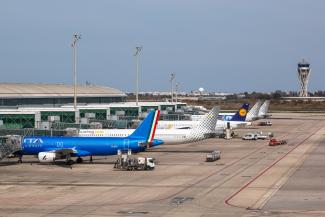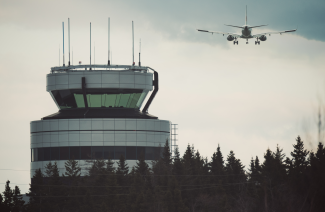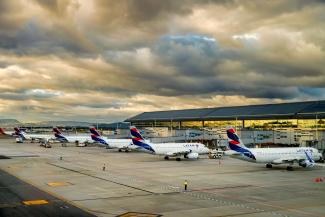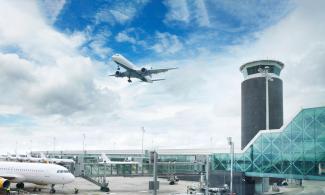Satellite-based communications (SATCOM) systems enabling Data Link Services (DLS) are a key element representing a safe, resilient, and secure solution to the modernisation of Air Traffic Management (ATM). In particular, the future operational concept of trajectory management in 4D – latitude, longitude, altitude and time – needs to be supported by a reliable, scalable, modular and efficient datalink technology and satellite communications will be a crucial part of a performance-based integrated Communication, Navigation and Surveillance (CNS) model. There is not a single and accepted Aeronautical communications roadmap worldwide, in fact there are many recent visions at programme level such as SESAR Airspace Architecture Study (AAS) and the Master Plan 2019, but each actor can have its own view. It is still uncertain and will depend mostly on:
- The traffic (both aircraft and data) demand forecast, which will determine the capacity limitations and the future needs.
- The technical and economic feasibility and of the various solutions providing the services, which will determine if they satisfy performance requirements, its capacity and costs for the actors deploying it
- The final price for the user, which will impact the decision making of the buyers of the service.
European regulation might also change direction and align towards a performance-based regulation that would support the ‘best-equipped, best-served’ principle. It would mandate a performance level to be achieved, thus allowing the election of which technology to equip, rather than mandating the equipage of a specific system that is expected to satisfy performance requirements determined at the moment of the regulation. The latter approach has been recognised to have low effectivity due to exemptions and administrative time to accept or reject them, for instance VDL2 and ADS-B mandates are due 2020 and equipage rates are low.
Before addressing the main aspects of the Satcom business, let us contextualise in the sector. Aeronautical telecommunications cover the highly specialized and mission critical communications such as aircraft-to-ground, aircraft-to-aircraft, and aircraft-to-satellite. The applications can be diverse, mainly divided into safety and non-safety related. Safety-related communications include Air Traffic Services (ATS), which serve flight management and Airline Operational Communication (AOC) services, dedicated to flight operation, maintenance and engineering activities. Non-safety related applications include for instance cabin in-flight connectivity such as passenger broadband. The system (and infrastructure) supporting the service behind the application can also be of two main types: terrestrial (using a ground network) or satellite-based. The following figure shows all the terrestrial and satellite-based systems in the CNS domains:
 Source: EASA NPA, EC CNS Mandates, PBN IR, SUR IR, COM IR, EUROCONTROL
Source: EASA NPA, EC CNS Mandates, PBN IR, SUR IR, COM IR, EUROCONTROL
SATCOM envisaged to fill the gap
Saturation of the ATM network is expected by mid-next decade (2025-2030), based on the current Very High Frequency (VHF) VDL2 implementation rate and forecast growth of the traffic. According to EUROCONTROL, capacity crunch is a real issue which may cause an uncontrolling increasing number of delays affecting severely the network. The industry feels that VDL2 is not enough and even though it will continue to be in operation during the next 20 years, the technology needs to be extended and complemented by satellite-based solutions in the medium and long term.
Satellite-based communications are not new in ATM, indeed significant effort and work has been developed for instance during the last decade within IRIS programme, a SESAR project funded by ESA and in partnership with INMARSAT.
Despite IRIS being a solid alternative in the short-medium term to complement VDLM2 and foster the multilink concept (combine terrestrial and satellite datalinks), the aviation sector still needs more capable, innovative and feasible alternatives for the long term to solve new challenges that may lie on the 3 V’s of data (Volume, Variety and Velocity). In other words, data required and generated by the aircraft could be high in volume, very varied, and required to be transferred at high speeds, requiring low latency and high availability and integrity for critical applications. For this reason, many business and investment opportunities related to satellite technology for aviation are arising nowadays.
Value chain and business models
The business entails a complex environment that can be shaped in a 3-segment value chain. Each stakeholder has a particular business model with various organisations and different financial sizes, cost drivers, revenue streams, main activities (products, services), service provision model and pricing schemes. This information would be fundamental to evaluate the economic impact of a new technology in the complete business environment.
ALG has developed the complete satellite-based communications for aviation value chain, including the three segments: space, aviation/drones and ground.

The relationship between the stakeholders in the value chain is complex and critical to the services delivered to the final users in the aviation segment, mainly airlines and drones, thus pilots and passengers.
All actors together constitute the ATM SATCOM ecosystem upon which the CONOPS will be built (includes terrestrial comms as well). Figure below depicts how currently each actor interacts within each other in order to enable SATCOM in ATM. The aircraft connects with either ground radio antennas or the satellites, operated by the satellite operator (SO). In SATCOM, the service is provided by the satellite service provider (SSP) who broadcasts the data or voice towards the ground stations and connects with the communication service provider (CSP). The CSP centralises all the communications and links with either the ANSP or the aircraft operator which is the final recipient of the information.

Satellite Operators
Satellite operators usually offer the following services/products:
- Fixed Satellite Services (FSS – Ku Band)
- Mobile Satellite Services (MSS – L Band, S Band)
- High-Throughput Satellite Services (HTS – Ku/Ka Band)
- Satellite capacity leasing to Satellite Service Providers (SSP): More and more the tendency is that the service is delivered by SSPs instead of operators.
Satellite operators market has been valued at 12.3 B€ in 2018, from which around 900 M€ would be related to aeronautical satellite communications. NSR has estimated that this market is dominated by FSS and HTS services with a total share of 40% each, being MSS only a 20% of the aero SATCOM market. However, MSS is expected to be dedicated to the cockpit communications, whilst HTS will be used for in-flight connectivity and smart aircraft.
In the aeronautical SATCOM services, the key global satellite operators are Inmarsat, Iridium, Intelsat, SES, Eutelsat, and Viasat. Inmarsat has steadily set the bar for flight-deck communications, with over nearly three decades of commitment to aviation safety services. More than 90% of the world’s aircraft crossing oceans use their safety and operational services for communication and surveillance today, over 12,000 aircraft in total.
Satellite Service Providers
Satellite service providers are those actors interfacing satellite operators and the end-users or customers. The service provider reach agreements (including SLAs) with the satellite operator to lease their capacity in order to offer its services. In some particular cases (GEE, GoGo, Aireon), service providers allocate some specific payload in the satellites of the operator to offer a particular enhanced service. In aviation, satellite service providers offer two different type of services, which respond to two different markets: cockpit communications and cabin communications:
- Cockpit communications for safety and operation services (SOS) are usually operated under L-band frequencies, and have very strong performance requirements.
- Cabin connectivity, either for Business and General Aviation (BGA) or for commercial aviation, are not safety-critical and demand a much higher bandwidth. The performance requirements for this service are not so restrictive, and hence, much more players are present in the market.
Satellite service providers also complement their connectivity services with Air-to-Ground (ATG) broadband mainly targeted for cabin connectivity.
Additionally to communications, new companies are setting up services in the surveillance domain. Aireon has embarked ADS-B payload in Iridium Next satellites to offer global aircraft tracking (space-based ADS-B).
CSPs and ANSPs
Analysing more in-depth the roles and relationships of CSPs and ANSPs business models in terms of the Datalink message type, there are two different options. AOC and ATS data will follow different provision models depending on whether the ANSP or CSP owns and operates the infrastructure. What does not vary, is that the ANSP always provides ATS messages and services to Airlines and the CSP always provides AOC messages directly to Airlines.
- In the case where the CSP owns the ground infrastructure, it will provide directly AOC messages to Airlines and the ATS messages to ANSPs (who will pay fees for the data) and will at its time provide ATS messages and services to Airlines. This step does not depend on the owner of the infrastructure.
- In the case where the ANSP owns the ground infrastructure, it will provide directly the ATS messages and services to Airlines and AOC messages to CSP (who will pay back for them) and at its time will send them to Airlines.

Currently, SITA and ARINC are the two main companies providing aeronautical terrestrial communication services worldwide, gathering almost all the market share. However, there are still some countries where these services are provided by local private or governmental companies, such as AEROTHAI (Thailand), ADCC (China), DECEA (Brazil) and AVICOM (Japan).
Business trends
There is an increased demand for bandwidth across all the aviation industry, in all domains, in-flight connectivity, ATS and AOC. New satellite operators players are arising and want to deploy their satellite networks from GEO to MEO and LEO to cope with this increased demand and significantly improve latency as a key lever for new connectivity applications.
Satellite operators are also shifting their business models from a vertically integrated model to a service provision model. Traditionally, in the vertically integrated model, operators built and managed the network offering to sell directly to end-users. Whilst, in the service provider model, there is clear separation between the operator and end-user via the use of a service provider. Furthermore, multiple service providers can connect with the operators’ network which expands the market reach of satellite operators. In turn, satellite operators are becoming also service providers.
The market is shifting towards a more connected and smart aircraft, where both the cockpit and the cabin will benefit from high bandwidth connectivity. Airlines will be able to monitor the health status of their assets in real time, and enhanced datalinks will enable ATC applications such as 4D. SATCOM voice communications market is expected to shrink, as the datalink increments its usage, being voice left only for emergency or punctual circumstances.
The higher demand on connectivity is leading towards heavy communication infrastructure investments. For instance, in Europe, the European Aviation Network (EAN) initiative combines Inmarsat’s multi-beam S-band satellite with nearly 300 ground towers implemented by Deutsche Telekom, it is easily and cost-effectively scalable. EAN is the world’s first fully integrated mobile satellite/terrestrial (LTE) communications network, developed for providing high-quality broadband passenger connectivity to short-haul aircraft throughout Europe.
Broadband connectivity indirect revenues are expected to grow abruptly, which will lead satellite service providers to reach commercial agreements with retail stores, advertisement and other non-aviation businesses to maintain competitiveness. Further consolidation of the market is expected in aviation with merging and acquisition between service providers, as currently there are many small new players.
Regarding aeronautical communication infrastructure, CSPs are key players in its modernisation. During the next decade, further rationalisation and consolidation of the ground infrastructure is expected, because of the implementation of integrated CNS systems, data-sharing networks (SWIM), and a shift from ground-based infrastructure to satellite-based infrastructure supported by ATM modernisation programmes SESAR and NextGen. Major current CSPs (SITA and ARINC) are expected to lead this endeavour. CSPs are also envisaged to invest strongly in digital transformation technologies. Cybersecurity, cloud services, data centers, and artificial intelligence applications will become the core value of CSPs offering.
Drones and UTM are expected to be disruptive in conventional ATM, future automation and its associated data transfer and processing requirements, with the application of new digital technologies. Demonstration projects are showing how environment and surveillance applications can be rendered with RPAS flying beyond radio line-of-sight (BRLOS) through the use of safe and secure satellite-based command and control data links. Space-based data link communication is expected to be a key technology for future BRLOS operations in non-segregated airspace, because of its ability to offer global, broadband and safe communications for both payload and safety communications.
As a conclusion, SATCOM market is experiencing growth but also a structural change. In the next few years, total aircraft are foreseen to increase in 20%, share of connected aircraft from 25% to 55%, connected seats from 10% to 30% and mobile data / user pcm to increase from 1 to 5 MB. This leads to 10 times more data traffic. In the long term those figures could significantly increase more and more. In this promising scenario, main industry players are moving to secure their position at 10 years sight, the ones moving faster and providing better service will be the ones governing this profitable market.











































































